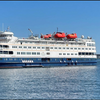MarAd: Cruise Occupancy Rates Rise
The report also found that the North American cruise market is highly concentrated, with three companies, Carnival, Royal Caribbean and the Star Group accounting for 96 percent of the North American passenger nights (Table 2). By itself, Carnival accounted for 7 brands and 53 percent of the passenger nights. The top five departure ports in terms of passengers accounted for 55 percent of the North American departures during the second quarter of 2006, down from 60 percent 4 years earlier (Table 3). The cruise lines have been expanding the number of home ports for their fleets, thus reducing the cost of cruising by eliminating air fares to major cruise ports. Cape Liberty, Houston, Mobile and Jacksonville have emerged as formidable cruise ports.
The significant seasonal variation in cruise departures from Florida ports reflects the repositioning of cruise vessels to/from Alaska trades (Table 4). Departures from Miami and Fort Lauderdale declined by 336 thousand passengers from the first to second quarter of 2006, while departures from Seattle, Vancouver, Whittier and Seward increased by a combined 337 thousand passengers over the same period.













